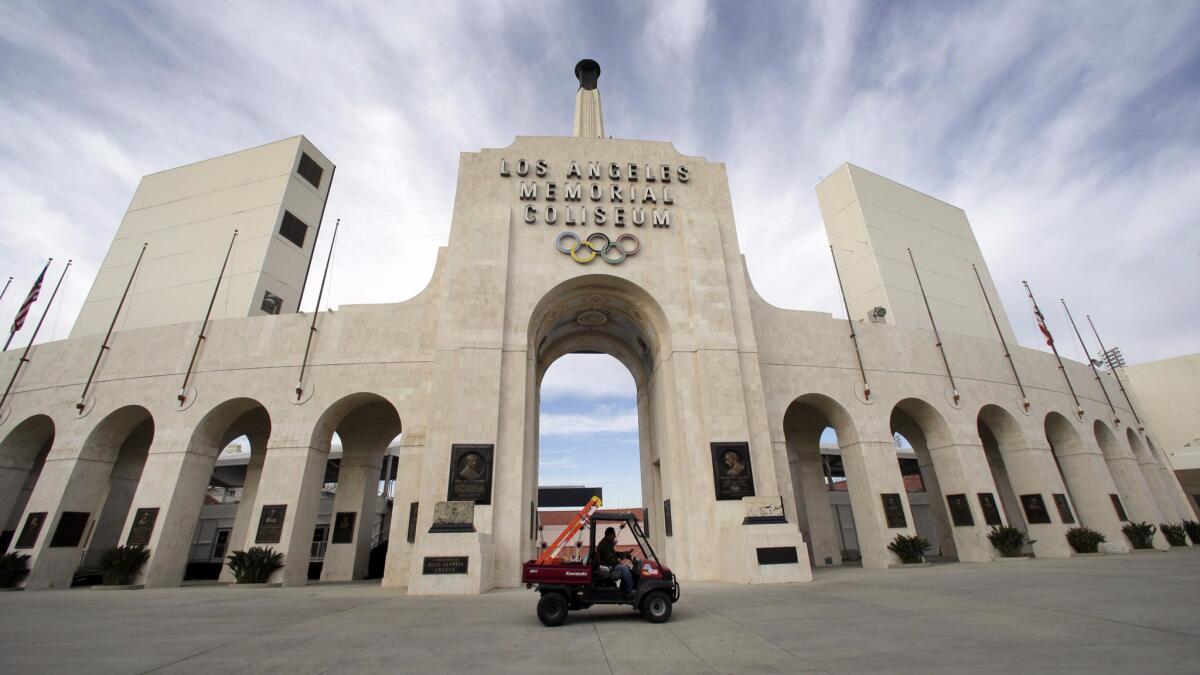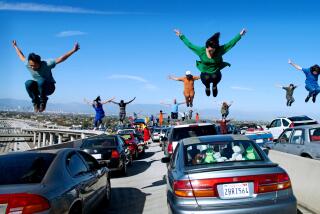Op-Ed: When in SoCal, do as the Romans (and the Greeks) do

California basks in its reputation as a new construct on the far edge of the continent, away from tradition, history and other burdens its settlers jettisoned on their way West. Southern California, in particular, has famously demolished its history — the mansions of Bunker Hill, a thriving community in Chavez Ravine, the Red Cars, even swaths of our fragile coastline — in favor of the next big thing.
That picture isn’t exactly wrong, but it isn’t the whole story either. There is history here, and if you look at it squarely you can see that California, and especially Southern California, was conceived and built out of one of the most revered of cultural traditions — classical antiquity.
L.A.’s interactions with classicism are so pervasive that we can easily be blind to their presence: The pyramidal topper on City Hall is a recreation of the Mausoleum of Halicarnassus, one of the Seven Wonders of the Ancient World. The courtyard plans of our famous midcentury modern houses are based on Roman domestic design. Sculptor Robert Graham’s sexy “Olympic Gateway” torsos, and the body builders at Muscle Beach, owe a debt to ancient forms and models. Esoteric groups like the Theosophists, who set up shop in San Diego, San Luis Obispo County and Hollywood in the early decades of the 20th century, established spiritual communities according to ancient precepts.
Like most Americans from the Colonial period to the early 20th century, California’s pioneers were steeped in two traditions — the Bible and the classics. They saw in this new state a possible Eden (in biblical terms) or Arcadia (the paradise imagined by Greek and Roman poets), where bountiful gardens and bucolic pastimes might epitomize an idyllic life. Boosters ballyhooed the region’s Mediterranean parallels; Elias “Lucky” Baldwin expressly called his rancho-turned-housing-development Arcadia.
From the Ionic columns of the Hollywood Masonic Temple to the acropolis of the Getty Center rising above the Sepulveda Pass, from the concrete arches of Memorial Coliseum to the aqueducts that bring water to the basin, what Southern California owes to the classic tradition is the shape of its landscape, myriad landmarks and artworks, and most important, the dream of an idealized lifestyle.
Here are a few examples of how Southern Californians have engaged with this lively tradition from the last 100 years.
The Farmers and Merchants Bank, downtown
The Beaux Arts style of a century ago is defined by its classical vocabulary, rich with fluted columns and massive surfaces of grey granite. Government bodies deployed these motifs to convey messages ranging from republican probity to imperial triumph, and businesses used them to impress their customers. The Farmers and Merchants Bank, the first incorporated bank in Los Angeles, was founded in 1871 by successful merchant and real estate speculator Isaias W. Hellman and Gov. John G. Downey. In 1905, Hellman hired Morgan and Walls to design its new headquarters at the corner of Main and Fourth streets. Its two-story faade evokes a Roman temple and Roman triumphal arches. The neglect of L.A.’s downtown core, starting in the 1960s, protected this building from the wrecker’s ball, and left intact one of the greatest collections of Beaux Arts buildings to survive in the U.S. The Farmers and Merchants building is one of the finest examples anywhere of the “temples of finance” architecture meant to reassure depositors in the days before the FDIC.
The Greek Theater, Griffith Park
After amassing a fortune from mining, Welshman Griffith J. Griffith acquired the old Rancho Los Feliz land grant. In December 1896 he donated 3,015 acres as “a Christmas present” to the people of Los Angeles: Griffith Park. Angelenos realized even then that the growing city was short on the open space required for their Arcadian dreams. The park “must be made a place of rest and relaxation for the masses, a resort for the rank and file, for the plain people,” Griffith instructed.
In December 1912, the mining magnate made a second Christmas present to L.A., one that had an expressly classical component: the funds to build an open-air Greek Theater (and a Hall of Science, the Griffith Observatory) in the park. It was a savvy public relations move: Griffith had been released from prison in 1906 after serving only two years for the attempted murder of his wife, a crime that generated the first of the city’s numerous “trials of the century.”
Griffith died before the site was chosen, but “the Greek” opened in the summer of 1931, designed by architect Samuel Tilden Norton. Although the evidence is largely hidden today by multiple renovations and electronics, the stage was modeled after a Greek temple, with ornamental detailing said to have been conceived by Griffith himself.
The Getty Villa, Malibu
Oilman J. Paul Getty’s 1970s replica of a Roman villa — a showplace built in part to compete with William Randolph Hearst’s San Simeon — is surely the best-known allusion to classical antiquity in Southern California. “What could be more logical,” Getty declared of his Greek and Roman art collection, “than to display it in a classical building where it might originally have been?”
Yet the initial reception of the villa is notorious. It elicited all manner of hand-wringing over issues of authenticity. Its pristine condition discomfited critics and brought forth many comparisons, positive and negative, with Disneyland. Its proximity in time to the classical kitsch of L.A.’s Mt. Olympus residential development and Caesar’s Palace in Las Vegas, both dating to the 1960s, didn’t help its cause.
However, the Getty Villa has since been re-contextualized. Visitors now first see it looking down through the seating of a new amphitheater — the latest in the region’s unequaled legacy of Greek theaters — as if it were an archaeological site. A campus of sleek buildings housing administration, education and conservation services is built into the canyon rim above the villa. The contrast lets the visitor perceive the barely old villa as an object worthy of respect, and conjures less Sleeping Beauty’s Castle and more a sophisticated dialogue between classicism and modernism.
“Urban Light,” LACMA
The Los Angeles County Museum of Art began as a small section of the Los Angeles County Museum of History, Science and Art built in Exposition Park in 1913, but it was soon apparent that there needed to be a facility devoted exclusively to art. In 1964 William Pereira & Associates designed a group of three pavilion-like structures for a new museum in Hancock Park, gracefully elevated on a central plaza above the street level of Wilshire Boulevard. Unfortunately, subsequent additions obscured the coherence and careful geometry of that original ensemble. For years, the museum turned its back on the city.
Then, in 2008, LACMA installed Chris Burden’s “Urban Light” on Wilshire where Ogden Drive used to edge the campus. The assemblage of 202 tightly arrayed cast-iron streetlamps in 17 styles completely transformed LACMA’s street presence. Primarily from the 1920s and 1930s, the lampposts are carefully restored and all painted gunmetal gray. Many feature fluted shafts and classicizing ornamentation, such as the Greek meander, or key, pattern. The whole evokes a brash Greco-Roman temple, with a clear reference to the authority older art museums claim through their classical facades.
“Venice Kinesis,” Venice Beach
Rip Cronk’s 2011 mural represents the third version of his signature work. All three iterations have depicted a seemingly contemporary California girl skating along Ocean Front Walk, but we also recognize in her pose (and in other references) a refashioned version of Botticelli’s “The Birth of Venus,” a Renaissance work whose central figure derived in turn from Greco-Roman sculptural types.
By depicting Venus with such fleeting and contemporary attributes as running shorts, halter-top and rollerskates, Cronk emphasizes our distance from the ancient sources while underscoring his appropriation of them and the long tradition they represent: a sophisticated embrace of the past through a humorous homage-cum-reconsideration.
The mural, first painted in 1980, has its roots in Postmodernism, which recognized, according to critic Umberto Eco, “that the past, since it cannot be destroyed, because its destruction leads to silence, must be revisited: but with irony, not innocently.”
In a cartoon thought-bubble the Venice Venus warns us that “History is myth.” Both, of course, are the source of the stories we tell ourselves to make sense of the world. In Cronk’s parody, the quiver lines indicating his skater’s forward momentum could just as easily refer to Southern California’s embrace of progressive change. At the same time, they remind us of where she’s coming from — a cultural legacy that reaches all the way back to antiquity.
Peter J. Holliday teaches the history of classical art and archaeology at Cal State Long Beach. He is the author of the recently published “American Arcadia: California and the Classical Tradition.”
Follow the Opinion section on Twitter @latimesopinionand Facebook
More to Read
A cure for the common opinion
Get thought-provoking perspectives with our weekly newsletter.
You may occasionally receive promotional content from the Los Angeles Times.










